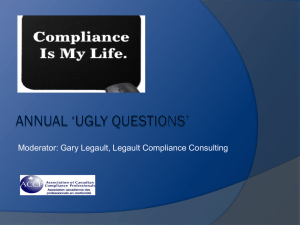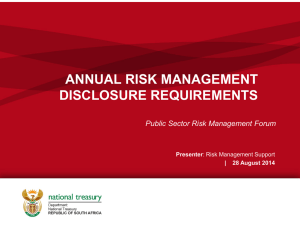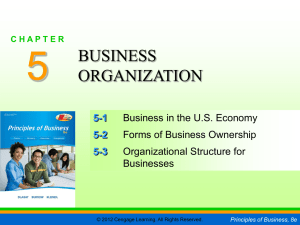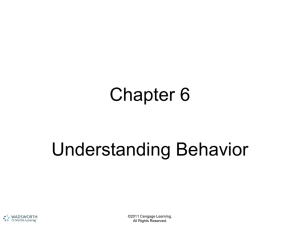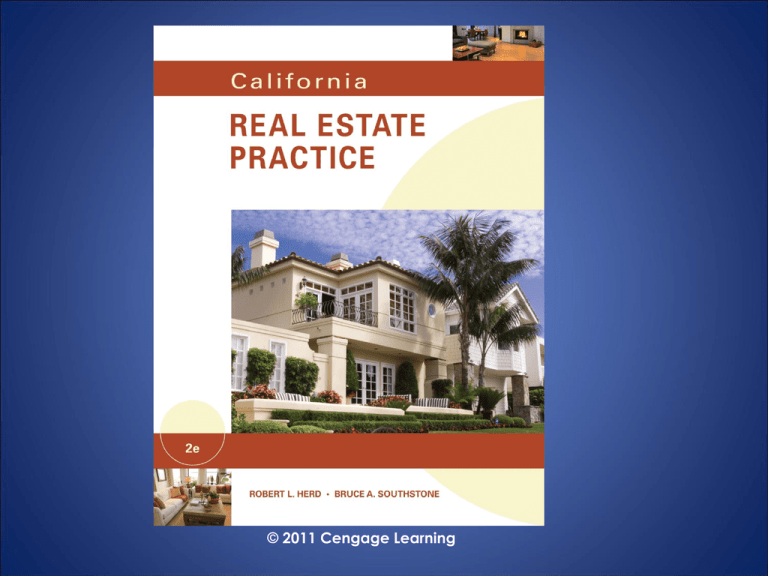
© 2011 Cengage Learning
Disclosures
Chapter 4
© 2011 Cengage Learning
RATIONALE FOR CHAPTER
•
•
A real estate agent has an absolute duty to protect the
interests of his or her client.
The client has an absolute right to know all facts that
are available to be able to make an informed decision.
© 2011 Cengage Learning
RATIONALE FOR CHAPTER
•
•
Mandatory disclosures create a standard for
licensees, buyers and sellers to rely on when
making decisions.
This chapter will help licensees understand which
disclosures are required.
© 2011 Cengage Learning
Focus of Presentation
There are significant benefits to full,
written disclosure to all parties to a
transaction.
© 2011 Cengage Learning
Focus of Presentation
Commercial real estate transactions
have their own set of disclosure rules,
however, this chapter deals primarily
with one-to-four residential units.
© 2011 Cengage Learning
Focus of Presentation
Understand fully the difference between
a fact and a material fact, and the
rationale behind the difference.
© 2011 Cengage Learning
Focus of Presentation
Difference between a disclosure and a
mandated disclosure, which is not an
option, but is required by law.
© 2011 Cengage Learning
Focus of Presentation
Difference between a client and a
customer, and the higher level of
fiduciary responsibility that must be
maintained with a client.
© 2011 Cengage Learning
Focus of Presentation
On-going duty to fully disclose material
facts as the escrow proceeds.
© 2011 Cengage Learning
Focus of Presentation
•
Different types of required disclosures
•
•
•
•
•
•
Agency
natural hazards
flood and/or fire hazard areas
earthquake special study zones
property disclosure statements
Have you ever encountered problems
with non-disclosures?
© 2011 Cengage Learning
CHAPTER FOUR OUTLINE
4.1 UNDERSTANDING MANDATED
DISCLOSURES
4.2 YOUR FIDUCIARY RESPONSIBILITIES
AND DISCLOSURES
4.3 AGENCY DISCLOSURE
4.4 DEATH OR AIDS DISCLOSURE
4.5 REAL ESTATE TRANSFER DISCLOSURE
STATEMENT (TDS)
4.6 AGENT’S INSPECTION DISCLOSURE –
HOW AND WHY?
© 2011 Cengage Learning
CHAPTER FOUR OUTLINE
4.7 SELLER FINANCING DISCLOSURE
4.8 ENVIRONMENTAL HAZARDS
DISCLOSURE
4.9 NATURAL HAZARDS DISCLOSURES
4.10 COMMON INTEREST SUBDIVISIONS
4.11 PRELIMINARY AND FINAL PUBLIC
REPORTS (SUBDIVISIONS)
4.12 RIGHT OF RESCISSION
4.13 CALIFORNIA ASSOCIATION OF
REALTORS® DISCLOSURE CHART
© 2011 Cengage Learning
UNDERSTANDING MANDATED
DISCLOSURES
•
•
Caveat emptor, or “buyer beware,” is a
thing of the past
“Disclose, disclose, disclose” today due
to our highly litigious society
© 2011 Cengage Learning
UNDERSTANDING MANDATED
DISCLOSURES
There are different disclosure standards
for residential one-to-four unit
properties and commercial property.
© 2011 Cengage Learning
UNDERSTANDING MANDATED
DISCLOSURES
•
•
The scope of this text deals primarily
with one-to-four unit residential
properties.
Disclosures are necessary with
commercial properties
•
•
phase I, II, and III environmental reports
income and expense statements
© 2011 Cengage Learning
UNDERSTANDING MANDATED
DISCLOSURES
•
•
•
Disclosure vs. full disclosure
Difference between a fact and a
material fact
Importance of giving full written
disclosure
© 2011 Cengage Learning
UNDERSTANDING MANDATED
DISCLOSURES
Mandated disclosures and the
importance of timing when giving
disclosures.
© 2011 Cengage Learning
YOUR FIDUCIARY RESPONSIBILITIES
AND DISCLOSURES
•
•
Difference between a client and a
customer
Difference between the two as it
pertains to the duties imposed on an
agent.
© 2011 Cengage Learning
YOUR FIDUCIARY RESPONSIBILITIES
AND DISCLOSURES
•
Duties imposed on the agent when
acting in a fiduciary relationship,
including the special area of dual
agency.
© 2011 Cengage Learning
YOUR FIDUCIARY RESPONSIBILITIES
AND DISCLOSURES
Fiduciary duty of an agent to discover
and give full written disclosure of visible
defects and other material facts about a
property or buyer that a principal should
know.
© 2011 Cengage Learning
YOUR FIDUCIARY RESPONSIBILITIES
AND DISCLOSURES
Even when no fiduciary duty exists, as
with an unrepresented principal, the
duty of full written disclosure still does.
© 2011 Cengage Learning
AGENCY DISCLOSURE
•
•
Proper time to give the mandated
written agency disclosure.
When and where agency election is
made and why this is important.
© 2011 Cengage Learning
AGENCY DISCLOSURE
•
•
Pitfall of ostensible agency
How and when that can this happen if
licensees are not careful.
© 2011 Cengage Learning
AGENCY DISCLOSURE
•
This happens when an agent is
representing one party and dealing with
an unrepresented party, such as a For
Sale By Owner, and the agent
inadvertently gives advice or direction
to the unrepresented party thereby
creating an undisclosed dual agency.
© 2011 Cengage Learning
AGENCY DISCLOSURE
Who the “real” agent is (the broker).
© 2011 Cengage Learning
AGENCY DISCLOSURE
An agent, or agents in a dual agency
situation, should do the best for their
respective client while not disclosing
unwarranted facts about either principal
that would harm them or weaken their
respective positions in the negotiations.
© 2011 Cengage Learning
AGENCY DISCLOSURE
Importance of communicating to the
client that even though both principals
in a transaction may be represented by
the same franchise, it may be two
distinctly different companies and,
therefore, single agency.
© 2011 Cengage Learning
AGENCY DISCLOSURE
Sub-agency and why it is seldom used
any longer because of the additional
liability it imposed on sellers and listing
agents.
© 2011 Cengage Learning
THE DISCLOSURE
PROCESS
Use of the acronym DEC, or Disclose –
Elect – Confirm.
© 2011 Cengage Learning
THE DISCLOSURE
PROCESS
•
•
Timing of the disclosure process.
California Department of Real Estate’s
mandate
•
•
can be done “at the earliest practical
moment” after an on-going relationship has
been established.
Define when this time is.
© 2011 Cengage Learning
THE DISCLOSURE
PROCESS
•
•
Different types of agency relationships
that can exist between the broker and
client.
Agency relationship exists between the
broker and the client, not the agent.
© 2011 Cengage Learning
DEATH AND DISCLOSURE
•
•
A natural death on the property, or a murder
or suicide should be disclosed for three years
from the date of the incident. If the death was
by AIDS, disclosure of the cause of death is
unnecessary.
If a potential buyer asks an agent if anyone
ever died of AIDS on the property, the agent
should refer him or her to the seller.
© 2011 Cengage Learning
STIGMATIZED PROPERTY
•
•
•
Reasons that a property may be considered
uninhabitable.
What may be a small issue to one person
may be huge to someone else, so the Golden
Rule would come into play if you are unsure
about his or her disclosure responsibilities.
If you are unsure, ask your broker.
© 2011 Cengage Learning
LICENSED CARE
FACILITIES
Be aware that a licensed care facility
that serves six or fewer people does not
have to be disclosed and that a larger
one would probably have to be
disclosed.
© 2011 Cengage Learning
REAL ESTATE TRANSFER
DISCLOSURE STATEMENT (TDS)
Types of properties included in the
mandated TDS-11 disclosures and
what issues about the property must be
disclosed.
© 2011 Cengage Learning
REAL ESTATE TRANSFER
DISCLOSURE STATEMENT (TDS)
Who must fill out the disclosure
statement, when and the nature of what
must be disclosed.
© 2011 Cengage Learning
REAL ESTATE TRANSFER
DISCLOSURE STATEMENT (TDS)
Various right of rescission periods
available to a prospective buyer.
© 2011 Cengage Learning
AGENT’S INSPECTION DISCLOSURE
– HOW AND WHY?
Exemptions to a seller having to fill out a
disclosure form and make note of the
fact that even if the seller is exempt, the
agent is not.
© 2011 Cengage Learning
AGENT’S INSPECTION DISCLOSURE
– HOW AND WHY?
Easton vs. Strassburger case
ramifications on the disclosure process
which now includes what the agent knew as
well as what they should have known.
© 2011 Cengage Learning
AGENT’S INSPECTION DISCLOSURE
– HOW AND WHY?
The statute of limitations two year
period for filing a claim against a
licensee regarding a disclosure
statement issue.
© 2011 Cengage Learning
INSECT INFESTATION
Different types of insect infestations that
are common in California
type of damage each can do to a structure,
and the tell-tale signs.
© 2011 Cengage Learning
WATER DAMAGE
Sources of water damage and the main
indicators that a problem exists.
© 2011 Cengage Learning
MATERIAL DETERIORATION
Different types of material deterioration
that can take place in and around a
property and the “red flag” issues
associated with them.
© 2011 Cengage Learning
STRUCTURAL FAILURE
•
Material deterioration with structural failure
•
•
•
how one leads to the other
various types of structural failure that can occur.
Any properties that you have had contact with
that had any type of structural failure and
what you observed.
© 2011 Cengage Learning
STRUCTURAL FAILURE
“Red flag” disclosures and how to
handle them.
© 2011 Cengage Learning
STRUCTURAL FAILURE
Benefits of getting a home inspection, a
home protection plan, and a pest
control inspection.
© 2011 Cengage Learning
SELLER FINANCING DISCLOSURE
Creative financing
Define
when it is mandatory (seller financing with
one-to-four-unit buildings).
© 2011 Cengage Learning
SELLER FINANCING DISCLOSURE
What is over-financed and how it affects a
seller.
© 2011 Cengage Learning
SELLER FINANCING DISCLOSURE
Who must disclose any seller financing in
a transaction (the arranger of credit).
© 2011 Cengage Learning
SELLER FINANCING DISCLOSURE
Dangers of a balloon payment.
© 2011 Cengage Learning
ENVIRONMENTAL HAZARDS
DISCLOSURE
•
Types of environmental hazard
•
•
•
•
lead- based paint
Asbestos
radon gas
Other types of environmental hazards
© 2011 Cengage Learning
ENVIRONMENTAL HAZARDS
DISCLOSURE
Why newer homes may be more
susceptible to radon gas than older
homes.
© 2011 Cengage Learning
ENVIRONMENTAL HAZARDS
DISCLOSURE
Why is it so important to have the
buyers sign the tear-out sheet at the
back of the Environmental Hazards
Disclosure booklet and place it in the
agent’s file?
© 2011 Cengage Learning
ENVIRONMENTAL HAZARDS
DISCLOSURE
When must the Hazardous Waste
Disclosure be given to a buyer (nonresidential).
© 2011 Cengage Learning
ENVIRONMENTAL HAZARDS
DISCLOSURE
•
•
Effects on humans of ingesting lead.
1978 is the cutoff date for the legal use
of lead-based paint.
© 2011 Cengage Learning
MILITARY ORDNANCE LOCATION
Discuss when and how the disclosure
of a military ordinance location must be
made.
© 2011 Cengage Learning
NATURAL HAZARDS DISCLOSURES
•
Earthquake safety
•
date of enactment of the ordinance (1/1/93)
• date of construction of the structures that
must be disclosed (prior to 1/1/60).
© 2011 Cengage Learning
NATURAL HAZARDS DISCLOSURES
Agent’s role in explaining any material
contained in the booklet and when the
client should be referred to another
professional.
© 2011 Cengage Learning
NATURAL HAZARDS DISCLOSURES
Special study zone maps
location
how wide the special study zone is (1/8 mile
on each side of a known active fault).
© 2011 Cengage Learning
NATURAL HAZARDS DISCLOSURES
Additional Natural Hazards Disclosures:
Referring to the Natural Hazards Disclosure
Statement, briefly discuss the following:
•
Very high fire hazard zones
•
State fire responsibility areas
•
Special flood hazard areas
•
Areas of potential flooding
© 2011 Cengage Learning
COMMON INTEREST SUBDIVISIONS
•
•
Common interest subdivision.
Homeowner’s association and what
powers they may have.
© 2011 Cengage Learning
COMMON INTEREST SUBDIVISIONS
Documents that must be given to a
prospective buyer of a property in a CIS
and the importance of each with
regards to full disclosure.
© 2011 Cengage Learning
COMMON INTEREST SUBDIVISIONS
Issues of the elderly woman with three
cats who buys a condominium, then
moves in, only to be told that she must
get rid of one of the cats or move as
there is a restriction of only two pets
allowed.
© 2011 Cengage Learning
COMMON INTEREST SUBDIVISIONS
Importance of getting and reading the
minutes of the last two years’ board
meetings to get a clear picture of what
is taking place in the complex.
© 2011 Cengage Learning
PRELIMINARY AND FINAL PUBLIC
REPORTS (SUBDIVISIONS)
Mandated issuance of the final public
report and the common interest
development general information
brochure before a buyer is fully
obligated to purchase in a new
subdivision.
© 2011 Cengage Learning
PRELIMINARY AND FINAL PUBLIC
REPORTS (SUBDIVISIONS)
Difference between a reservation to
purchase (pink slip) and a final public
report (white slip), and the rights of the
parties therein.
© 2011 Cengage Learning
RIGHT OF RESCISSION
Types of sales transactions and mandated
disclosures that allow a buyer a specified
time to rescind the contract.
Mello-Roos Disclosure
Time-share
Truth-in-Lending Act
Undivided Interest Subdivisions
Interstate Land Sales Full Disclosure Act
Home equity sales
© 2011 Cengage Learning
OTHER REQUIRED
DISCLOSURES
Following additional required disclosures:
•
Megan’s Law (sex offender registration and
disclosure)
•
Water heater bracing
•
Home energy ratings
•
Smoke detector ratings
•
Smoke detector notice
•
Home inspection notice
© 2011 Cengage Learning



